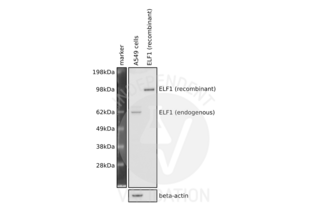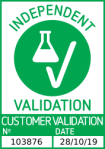ELF1 antibody (C-Term)
Quick Overview for ELF1 antibody (C-Term) (ABIN184790)
Target
See all ELF1 AntibodiesReactivity
Host
Clonality
Conjugate
Application
Grade
-
-
Binding Specificity
- C-Term
-
Purpose
- ELF1
-
Sequence
- AMKQNELLEP NSF
-
Specificity
- This antibody is expected to recognise both reported isoforms.
-
Cross-Reactivity
- Human, Mouse
-
Purification
- Purified from goat serum by ammonium sulphate precipitation followed by antigen affinity chromatography using the immunizing peptide.
-
Immunogen
- Peptide with sequence C-AMKQNELLEPNSF, from the C Terminus of the protein sequence according to NP_758961.1, NP_001138825.1.
-
Isotype
- IgG
-
-
-
-
Application Notes
-
Immunohistochemistry: Paraffin embedded Human Thymus. Recommended concentration: 2.5 μg/mL.
Western Blot: Approx 65 kDa band observed in Human Lymph Node and Tonsil and in Mouse Thymus lysates (calculated MW of 64.9 kDa according to Human NP_001138825.1 and 62.3 kDa according to Mouse NP_001273341.1). Recommended concentration: 0.1-0.3 μg/mL. Appro
Peptide ELISA: antibody detection limit dilution 1:64000.
-
Restrictions
- For Research Use only
-
-
- by
- Dittmann Lab, Microbiology Department, NYU Langone Health, NYU School of Medicine
- No.
- #103876
- Date
- 10/28/2019
- Antigen
- ELF1
- Lot Number
- C2P2
- Method validated
- Western Blotting
- Positive Control
A549 (endogenous ELF1), ELF1 recombinant protein
- Negative Control
- Notes
Passed. ABIN184790 specifically recognizes endogenous ELF1 in A549 cell lysates and recombinant human ELF1.
- Primary Antibody
- ABIN184790
- Secondary Antibody
- rabbit anti-goat HRP-conjugated antibody (Invitrogen, 31402)
- Full Protocol
- Grow A549 cells (ATCC, CCL-185) in DMEM medium (Corning, 10-013-CV) supplemented with 10% FBS (Atlanta biologicals, S11150) and Penicillin-Streptomycin (Corning, 30-002-CI), at 37°C and 5% CO2 to 3x104 cells/cm2 in 2ml on a 6 well plate (Costar, 3516).
- Wash cells once with 1x PBS treat with trypsin (Corning, 25-053-CI).
- Take cells up in growth medium.
- Wash cells once with 1x PBS.
- Resuspend approximately 2.05x105cells/well in 50-100µl 1x LDS sample buffer (Life Technologies, B0007). As positive control, take 20µg recombinant ELF1 (Abnova, H00001997-P01) in 1x LDS sample buffer.
- Denature samples for 3min at 95°C and subsequently keep them on ice.
- Separate samples on a Bolt 4-12% Bis-Tris Plus Gel (Invitrogen, NW04122) in an electrophoresis chamber (Mini Gel Tank, Invitrogen, A25977) for 30min at 80V and then for 60min at 120V.
- Transfer proteins onto nitrocellulose membrane (Invitrogen, IB23002) using an iBlot 2 Gel Transfer Device (Invitrogen).
- Block the membrane with TBS containing 0.05% Tween (TBST) containing 5% skim milk for 1h at RT.
- Incubation with primary
- goat anti-ELF1 antibody (antibodies-online, ABIN184790, C2P2) diluted 1:2500 in TBST containing 0.5% skim milk ON at 4°C.
- loading control mouse anti-beta actin antibody (Invitrogen, MA5-15739) diluted 1:5000 in TBST containing 0.5% skim milk ON at 4°C.
- Wash membrane 3x for 10min with TBST.
- Incubation with secondary
- rabbit anti-goat HRP-conjugated antibody (Invitrogen, 31402) diluted 1:20000 in TBST containing 0.5% skim milk for 1h at RT.
- goat anti-mouse HRP-conjugated antibody (Invitrogen, G21040) diluted 1:10000 in TBST containing 0.5% skim milk for 1h at RT.
- Wash membrane 3x for 10min with TBST.
- Reveal protein bands using SuperSignal West Dura Extended Duration Substrate (ThermoFisher Scientific, 34075) and a ChemiDoc MP Imaging System (Bio-Rad).
- Experimental Notes
ABIN184790 reveals a protein with an apparent molecular weight of approximately 62kDa. The expected molecular weight for endogenous human ELF1 is approximately 67kDa. The antibody also reveals a recombinant GST-tagged protein at the expected molecular weight (theoretical MW 93.9kDa).
Other ELF1-antibody dilutions were tested, but a dilution of 1:2500 was found optimal in terms of minimal background and strength of signal.
Validation #103876 (Western Blotting)![Successfully validated 'Independent Validation' Badge]()
![Successfully validated 'Independent Validation' Badge]() Validation ImagesFull Methods
Validation ImagesFull Methods -
-
Format
- Liquid
-
Concentration
- 0.5 mg/mL
-
Buffer
- Supplied at 0.5 mg/mL in Tris saline, 0.02 % sodium azide, pH 7.3 with 0.5 % bovine serum albumin.
-
Preservative
- Sodium azide
-
Precaution of Use
- This product contains Sodium azide: a POISONOUS AND HAZARDOUS SUBSTANCE which should be handled by trained staff only.
-
Handling Advice
- Minimize freezing and thawing.
-
Storage
- -20 °C
-
Storage Comment
- Aliquot and store at -20°C, with minimal freeze/thawing. A working aliquot may be refrigerated at 4°C for a few weeks and still remain viable.
-
-
- ELF1 (E74-Like Factor 1 (Ets Domain Transcription Factor) (ELF1))
-
Alternative Name
- ELF1
-
Background
- ELF1, E74-like factor 1 (ets domain transcription factor), OTTHUMP00000018310, ets-related transcription factor Elf-1
-
Gene ID
- 1997, 13709
-
NCBI Accession
- NP_758961, NP_001138825
Target
-


 (1 validation)
(1 validation)



